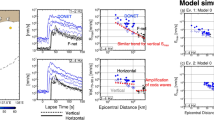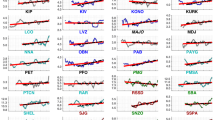Abstract
Ocean waves are acknowledged to be the cause of microseisms ubiquitous in seismograms. The excitation and source locations of microseisms, however, remain enigmatic. In this study, the characteristics of microseisms generated by extraordinary storms in the Indian Ocean in the middle of May, 2007 were investigated. Spectral analysis showed that two huge ocean-swell systems, one that began around May 9 and the other around May 14, generated strong microseisms: single-frequency (SF) microseisms ranging from 0.04–0.06 Hz and double-frequency (DF) microseisms ranging from 0.08–0.12 Hz. The dispersion of ocean waves generated a progressive frequency shift of microseismic peaks. A comparison among microseisms at deep-ocean islands and coastal seismic stations indicated that most of the dispersed DF microseisms followed SF microseisms generated in coastal areas. However, a dispersed DF microseism can also occur with no preceding excitation of an SF microseism; this has been observed at deep-ocean islands and coastal stations simultaneously, and implies that some of the DF microseisms recorded at inland stations may have been generated in the deep ocean. Frequency-wavenumber analysis of the DF band indicated the presence of non-dispersed body-wave microseisms when the swells were in the middle of the ocean. However, microseisms showing a progressive frequency shift of spectral intensity propagated dominantly as surface-waves and were observed when the swells were close to the coast and when a favorable condition for wave-wave interaction reached in the deep ocean.
Similar content being viewed by others
References
Ardhuin, F., Stutzmann, E., Schimmel, M., and Mangeney, A., 2011, Ocean wave sources of seismic noise. Journal of Geophysical Research, 116, C09004, doi:10.1029/2011JC006952.
Ardhuin, F., Balanche, A., and Stutzmann, E., 2012, From seismic noise to ocean wave parameters: General method and validation. Journal of Geophysical Research, 117, C05002, doi:10.1029/2011JC007449.
Aster, R.C., McNamara, D.E., and Bromirski, P.D., 2008, Multidecadal climate-induced variability in microseisms. Seismological Research Letters, 79, 194–202.
Bromirski, P.D. and Duennebier, F.K., 2002, The near-coastal microseism spectrum: Spatial and temporal wave climate relationships. Journal of Geophysical Research, 107, doi:10.1029/2001JB000265.
Bromirski, P.D., Duennebier, F.K., and Stephen, R.A., 2005, Midocean microseisms. Geochemistry, Geophysics, Geosystems, 6, Q04009, doi:10.1029/2004GC000768.
Bromirski, P.D., Stephen, R.A., and Gerstoft, P., 2013, Are deepocean- generated surface wave microseism observed on land? Journal of Geophysical Research, 118, 1–20.
Chevrot, S., Sylvander, M., Benahmed, S., Ponsolles, C., Lefevre, J.M., and Paradis, D., 2007, Source locations of secondary microseisms in western Europe: Evidence for both coastal and pelagic sources. Journal of Geophysical Research, 112, B11301, doi:10.1029/2007JB005059.
Ebeling, C.W., 2012, Inferring ocean storm characteristics from ambient seismic noise: A historical perspective. In: Dmowska, R. (ed.), Advances in Geophysics, Vol. 53. Academic Press, Oxford, UK., p. 1–33.
Ebeling, C.W. and Stein, S., 2011, Seismological identification and characterization of a large hurricane. Bulletin of the Seismological Society of America, 101, 399–403.
European Space Agency, 2007a, Huge waves that hit reunion island tracked from space. ScienceDaily, May 16, 2007. Retrieved October 1, 2013, from http://www.sciencedaily.com/releases/2007/05/ 070516095230.htm.
European Space Agency, 2007b, Huge waves from one storm slam coasts some 6000 km apart. ScienceDaily, May 30, 2007. Retrieved October 1, 2013, from http://www. sciencedaily.com/releases/ 2007/05/070530112033.htm.
Friedrich, A., Kruger, F., and Klinge, K., 1998, Ocean-generated microseismic noise located with the Grafenberg array. Journal of Seismology, 2, 47–64.
Gualtieri, L., Stutzmann, E., Capdeville, Y., Ardhuin, F., Schimmel, M., Mangeney, A., and Morelli, A., 2013, Modelling secondary microseismic noise by normal mode summation. Geophysical Journal International, 193, 1732–1745.
Gerstoft, P. and Tanimoto, T., 2007, A year of microseisms in southern California. Geophysical Research Letters, 34, L20304, doi: 10.1029/2007GL031091.
Hasselmann, K., 1963, A statistical analysis of the generation of microseisms. Reviews of Geophysics, 1, 177–209.
Haubrich, R.A. and McCamy, K., 1969, Microseisms: Coastal and pelagic sources. Reviews of Geophysics, 7, 539–571.
Haubrich, R.A., Munk, W.H., and Snodgrass, F.E., 1963, Comparative spectra of microseisms and swell. Bulletin of the Seismological Society of America, 53, 27–37.
Kennett, B.L.N., Engdahl, E.R., and Buland, R., 1995, Constraints on seismic velocities in the earth from travel times. Geophysical Journal International, 122, 108–124.
Longuet-Higgins, M.S., 1950, A theory of the origin of microseisms. Philosophical Transactions of the Royal Society of London. Series A, 243, 1–35.
Obrebski, M.J., Ardhuin, F., Stutzmann, E., and Schimmel, M., 2012, How moderate sea states can generate loud seismic noise in the deep ocean. Geophysical Research Letters, 39, L11601, doi:10.1029/2012GL051896.
Rost, S. and Thomas, C., 2002, Array seismology: methods and applications. Reviews of Geophysics, 40, 1008, doi:10.1029/2000RG000100.
Stephen, R.A., Spiess, F.N., Collins, J.A., Hildebrand, J.A., Orcutt, J.A., Peal, K.R., Vernon, F.L., and Wooding, F.B., 2003, Ocean seismic network pilot experiment. Geochemistry, Geophysics, Geosystems, 4, 1092, doi:10.1029/2002GC000,485.
Stutzmann, E., Ardhuin, F., Schimmel, M., Mangency, A., and Patau, G., 2012, Modelling long-term seismic noise in various environments. Geophysical Journal International, 191, 707–722.
Sutton, G.H. and Barstow, N., 1990, Ocean-bottom ultralowfrequency (ulf) seismoacoustic ambient noise: 0.002 to 0.4 Hz. Journal of the Acoustical Society of America, 87, 2005–2011.
Tanimoto, T., 2007, Excitation of microseisms. Geophysical Research Letters, 34, L05, 308, doi:10.1029/2006GL029,046.
Tolman, H.L., 2009, User manual and system documentation of WAVEWATCH III version 3.14. NOAA/NWS/NCEP/MMAB Technical Note, 276, 194 p.
Author information
Authors and Affiliations
Corresponding author
Rights and permissions
About this article
Cite this article
Sheen, DH. Microseisms from huge Indian Ocean storms in May 2007. Geosci J 18, 347–354 (2014). https://doi.org/10.1007/s12303-013-0068-1
Received:
Accepted:
Published:
Issue Date:
DOI: https://doi.org/10.1007/s12303-013-0068-1




